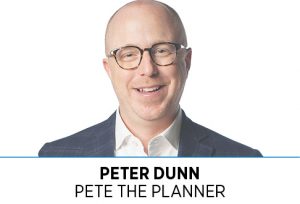Subscriber Benefit
As a subscriber you can listen to articles at work, in the car, or while you work out. Subscribe Now Dear Pete,
Dear Pete,
My wife and I are both 57 years old and plan to retire when we reach the full retirement age of 67. Based on some back-of-the-napkin math, I think we’ll need about $2 million to retire successfully, in addition to Social Security, and some real estate income. Here’s the problem: We only have about $1 million right now. Between the both of us, we’re investing a total of $2,000/month right now. If it took us 35 working years to accumulate $1 million, how in the world are we supposed to come up with another $1 million in just 10 years?
—Richard, Columbus
Every once in a while, I get an email that brings me nearly uncontrollable joy. Richard, you’ve just sent me one of those emails. And in return for the gift you gave me, I’m going to give you an incredible gift, too. Ready for it? Here it comes.
The hard work is done. You will more than likely have over $2 million at age 67.
At times, it seems like my column is an open love letter to mathematics, and this particular column won’t do anything to abate that assertion. Because of how compounding interest works, most people will accomplish their retirement asset goal when the value of their account is half of what they’ll need it to be, just 10 years out from retirement. Add on the fact that you’ll be adding $2,000/month to the pile for the next 10 years, and your quest for $2 million starts to look rather pedestrian.
If for some reason your goal was to accumulate another $1 million from scratch over the next 10 years, without the help from your current $1 million, your task would be quite difficult. But you’ve already done your part. For 35 years, you made decisions that have led to the accumulation of $1 million. Now, that $1 million will do most of the rest of the work.
Obviously, you didn’t share your risk tolerance or investment strategy with me in your email, but your goal to accumulate $2 million by age 67 is achievable because you need only a rather modest rate of return to succeed. If you weren’t contributing an additional $2,000/month, you’d need a tick above a 7% rate of return to reach $2 million. But since you’re inviting $2,000/month to the party, you’ll need to achieve only about 5.25% average return to succeed.
Which, of course, begs the question: What does it take to earn a 5.25% rate of return on a regular basis? I can’t guarantee you’ll get that sort of return over the next 10 years, and it’s highly unlikely you’ll find a financial institution that will guarantee it, either, but the stock and bond markets, when used in conjunction, have proven this task to be relatively easy.
A blended portfolio consisting of 60% stocks and 40% bonds (commonly called a 60/40 mix) has returned 9.78% annually over the last 10 years (period ending 12/31/20). And while past performance is not indicative of future performance, most investment professionals can help you construct a similar portfolio that achieves similar returns within your risk tolerance.
It’s possible you accumulated your first $1 million without taking market risks, but I doubt it. If you did, however, and you’re hoping to get to $2 million without taking market risks, your chances of doing so successfully are slim to none, especially at a $2,000/month commitment. This possibility is the precise reason you need a healthy relationship with a trusted investment adviser. Too often, pre-retirees make uninformed last-second decisions that result in either taking on unsuitable risks or unknowingly getting too conservative. In either instance, retirement failure is the result.
I can’t tell you whether your risk tolerance can handle the risks associated with growing your nest egg from $1 million to $2 million over a 10-year period. However, I can tell you a 5.25% annual rate of return is incredibly realistic and achievable, if your risk tolerance supports it.
The importance of investing in accordance with your risk tolerance is certainly one takeaway here, but the other takeaway involves every article-clipper on the planet cutting this column out and sending it to a young person. An early commitment to saving is what got the job done here, and now you get to reap the rewards of that decision, Richard. Well done, sir. Well done.•
__________
Dunn is CEO of Your Money Line powered by Pete the Planner, an employee-benefit organization focused on solving employees’ financial challenges. Email your financial questions to [email protected].
Please enable JavaScript to view this content.
